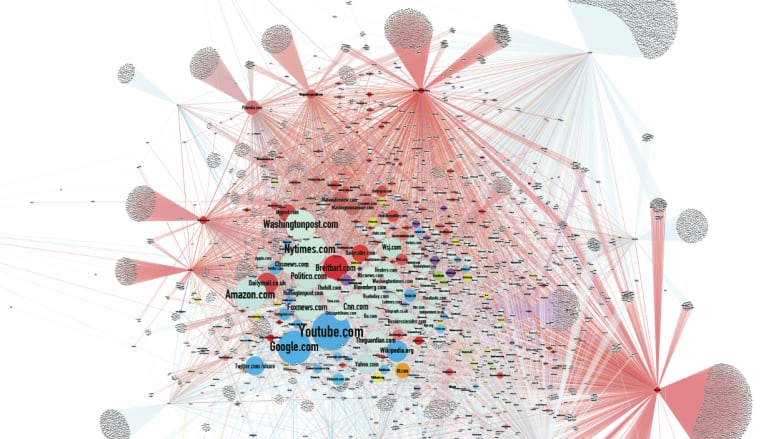How fake news spreads

For a large part of 2016, there's been a ton of discussion about fake news: How it spreads online, why it spreads in the first place, andwho is involved in reading, believing, and spreading false stories.
It's a complicated issue with many angles. Fake news spreads because sometimes, people believe what they want to believe. It spreads because some people want to make money from it. It spreads because of political agendas.
It spreads because truth, and what's now called "post-truth" have an enormous arena in which to compete:
The internet.
And the very mechanics of the complex systems of the internet are a big part of how and why fake news spreads.
Jonathan Albright is a professor at Elon University in North Carolina.
He researches social news, and, more recently, online propaganda. To study the way these so-called "fake news" stories spread, Jonathan looked at hundreds of stories that were tagged by academics as "inaccurate" or "propaganda." He came up with the term "micropropoganda" to describe what most people have called "fake news."
A lot of the finger-pointing has been at Facebook. The argument is that the Facebook algorithm favours and promotes stories that have lots of likes, shares, and so on. So you have a false story like the so-called Pizzagate story (about an underground pedophile ring in the basement of a pizzeria in Washington). If there's enough engagement with it, it shows up more. If it shows up more, more people see it and share it. And the "truth" of the story matters less and less.
But according to Jonathan, it isn't just Facebook that's the problem. It isn't even social media.

There are all these multi-coloured circles of different sizes, connected by a web of lines. Each circle represents a website. And the lines show a network of fake news, anti-science, hoax, and misinformation.
When you look at the image, what you notice is that the bigger circles in the middle are mostly mainstream media sites. Things like The New York Times, CNN, The National Review, Slate, and Fox News.
But surrounding those are smaller "fringe" sites, or what Jonathan calls satellites. Jonathan thinks that the spread of fake news happens because of the way these fringe sites link to mainstream media.
So fringe sites "surround" traditional news media like satellites, by linking over and over again to their content.
"You can see that these smaller right-wing sites have basically populated the entire network of news...the left wing media and centre are distant from social media... if you look at this map, these smaller sites have basically populated the area around Google, around Youtube, around Twitter. So it shows an interesting strategy, almost like a virtual battleground," he says.
It's a pretty effective use of the web. Simply...linking. A LOT.
But in the run-up to the recent American election, it was even more effective because media like the New York Times, WashingtonPost and MSNBC essentially ignored these fringe sites. In doing so, they isolated themselves.

It goes beyond the simple sharing of links, Jonathan believes, because, when you think about it, that's always been the way news outlets establish their credibility online. But it gets a bit more ominous, he adds, when bots, or programs designed to mimic people, also join the fray, sharing links on social media - or even engaging in online conversation.
But even without the threat of bots,humans do a pretty good job of mucking things up.
So can this trend be reversed, or is the web being fundamentally destabilized, at least in the way people consume and use media?
"Maybe there needs to be a new definition of the web," he says. And, he adds, in a political sense, the left needs to engage the right in the same way.
Jonathan's original essay on web "micropropaganda" can be found here.












_(720p).jpg)


 OFFICIAL HD MUSIC VIDEO.jpg)
.jpg)



























































































